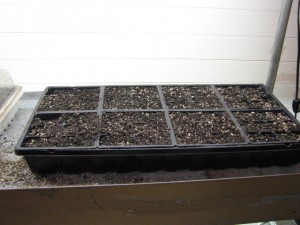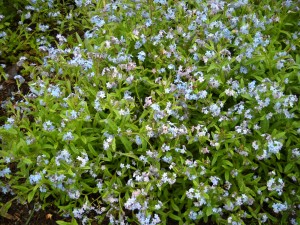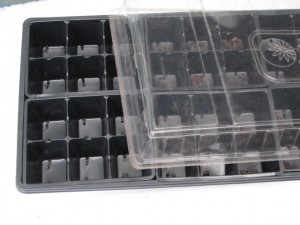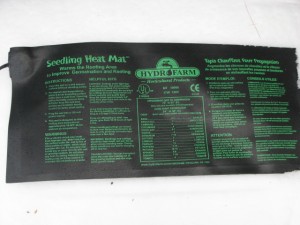Spring Forth Into Spring
This is a busy time for all of us in the garden. Not only are weeds up, some of them are already blooming. I try real hard to keep weeds from spreading their seeds in my garden beds, so I am doing my best to pull them now before they bloom and make seeds. And there is so much else to do I’m not sure if I have time to write this column!
Apple and crabapple trees are blooming everywhere, which draws my eyes to them. I can’t help but notice that so many need a little late pruning. What I keep seeing are root sprouts coming up alongside the trunk of these lovely trees, which is a distraction. And it only takes 5 minutes with a pair of loppers or a hand saw to remove those shoots.
While you’re at it, you may wish to take off any little branches that are sprouting from the main trunk below the first scaffold branches (those larger branches that reach out and up, and that have all those blossoms on them). A nice clean trunk is much better than one cluttered with unwanted sprouts.
Then there is the vegetable garden. I know we will still have frost here in Cornish Flat, so all those tomatoes and peppers and squash that I have started by seed inside need to stay in their pots. What I can do now, however, is” harden off” those seedlings. Hardening off is the process of getting seedlings ready for life outdoors.
Each nice day I should (but don’t always) carry all 12 trays of seedlings outdoors so my plants can work on their tan. That’s right, seedlings are like us – they need to start with just a little sunshine and breeze each day. Two hours of morning sun is good for a start, then 4 hours, then 2 hours of afternoon sun, and so on, increasing exposure until their leaves won’t burn or dry out even if they’re in the sun all day. If you buy seedlings it’s good to give them time to get used to the outdoors, too. Greenhouses do shelter seedlings considerably.
Right now I have thousands of forget-me-nots (Myosotis sylvatica) blooming everywhere: in garden beds, in the lawn, in the vegetable garden – even on the banks of my little stream (they love water). If you don’t have this fabulous, exuberant flower, you should. I wish I could give every reader a clump, but I bet one of your neighbors will share some with you, as most everyone has it. I rarely see them for sale at nurseries, but a few of the better ones do. Many flower books say they are biennials, but I’m not sure that’s true. Biennials only bloom in their second year, and then die. I have so many, it’s hard to know if they are re-seeding or coming back from their roots. So they may be perennials.
While weeding a patch of daffodils recently, I decided to take advantage of the fact that I had thoroughly loosened the soil surface. I spread my favorite organic fertilizer, Pro-Gro over the soil surface and scratched it in with my favorite weeder, the CobraHead. I had notice that those daffies were not flowering as previous years and decided to give the soil some extra nutrition and get rid of the weeds that were competing with them. Next spring I should have better blossoms.
Some gardeners like to divide big clumps of daffodils, though I generally don’t get around to it. The problem is that by fall I don’t know where those big clumps that need dividing are. The solution? Make some markers now and stick them in the soil. That works for marking places that need more bulbs, too.
It’s past time to rake off that leaf mulch or straw if you covered your vegetable garden with mulch last fall. I just raked mulch off my beds and into the walkways last week. By exposing the soil to the sun I do 2 things: I let the soil warm up and dry out more quickly, and I encourage weed seeds to germinate. I want the weeds to germinate before I plant so that I can hoe them over or pull them out, killing them before I plant. I also have a flame weeder which will burn off dozens of small annual weeds with a single, quick pass. (Available at Johnny’s Seeds or Fedco Seeds). But it does use propane, so is not as eco-friendly as hoeing.
Traditional gardeners grow their carrots, corn and cauliflower in narrow rows on flat ground. I don’t. I have mounded up beds that are 3 feet wide and 6 to 8 inches higher than the walkways. Wide beds produce more planting space in a garden when compared to those with narrow rows because there are fewer walkways. The wide, higher beds allow roots to spread wider and deeper than in traditional beds, and dogs and kids tend to stay out of them.
But if you have a sunny, warm weekend, don’t spend all day pulling weeds or working. Take time to sit and enjoy your flowers – and the butterflies, kids and dogs that love the garden, too.
Henry’s Web site is www.Gardening-Guy.com. It now has a search engine for finding any past columns you might have missed.
Starting Seedlings Indoors
Before we launch into this week’s article…
Gardening Classes with Henry
Lebanon College: Gardening: A Practical Workshop. Garden writer Henry Homeyer will teach you the basics of organic vegetable and flower gardening. From garden design to seed-starting , planting, watering, weeding, mulching, and harvesting, this course will give each student practical knowledge of gardening. Tuesday nights from 6:30-8:30 for 5 weeks, April 3-May 2.Contact Lebanon College to reserve a spot for this5-part workshop www.lebanoncollege.edu or call 603-448-2445.
AVA Gallery, Lebanon. Henry will teach 3 classes at AVA Gallery this spring. You may sign up for one or all of these workshops:
Sculpting the Living Landscape: Starting Flowers from Seed
April 9; Monday, 6:30–8:30pm; One 2-hour class
Sculpting the Living Landscape: Perfect Perennials for the Upper Valley Garden
April 23; Monday, 6:30–8:30pm; One 2-hour class
Sculpting the Living Landscape: Organic Techniques for Enriching Soil and Managing Pests
May 7; Monday, 6:30–8:30pm; One 2-hour class
For more information go to www.avagallery.org or call 603-448-3117.
Starting Seedlings Indoors
As winter morphs into spring, I get antsy. I want to start growing things. Even though it is still too early for starting most things by seed, it is the right time to plant artichokes, onions, peppers and leeks indoors. Tomatoes? Not until April. Squash? Not until May.
Whatever and whenever you start, there are several variables that need to be controlled: light level, moisture, available fertilizer and temperature. Pay attention to these factors and you will do well. The first thing I do each year is get out my lights. Starting seedlings on windowsills really doesn’t work for most things. Little seedlings get tall and leggy, reaching for light if all they get is a few hours of sunshine in a window.
My lights were an investment, but have paid for themselves many times over the years. I start 200-300 seedlings each year and seeds are much cheaper than seedlings bought in 6-packs at the nursery. And I often start 20 kinds of tomatoes and half a dozen types of hot peppers – most of which I would never find for sale.
This year I have upgraded my lights. The old T-12 (fat style) fluorescent tubes lose their potency over time, and are less efficient than the modern, thinner T-8 tubes. And the T-12 lights are being phased out due to federal energy regulations. So if you have old lights, think about upgrading. LED lights are also available, and while considerably more expensive than fluorescents, they are more energy efficient. I got some from Sunshine Systems (www.sunshine-systems.com or 866-576-5868).
If you don’t want to invest in a plant stand, a card table will do if you’re not starting too many plants. Still, I like my stand because it will hold 2 flats of plants on each shelf, and has 3 shelves – that’s enough for about 200 seedlings. Gardener’s Supply (www.gardeners.com or 888-833-1412) has some nice plant stands, but they are not cheap. Try your local garden center, too, or think about making your own. If buying, look for a stand that allows you to raise the lights as plants grow – 6 inches above the plants is ideal. One last thing: only run your lights 14 hours a day. They need their beauty rest, too.
When seeds first germinate they are very sensitive to drying out, so I like the clear plastic covers that are sold to fit over flats. They hold the moisture like little greenhouses. If you use them, plant things that germinate at the same rate in any given flat – germination times can vary from 3 to 18 days, depending on the plant species. Remove the covers as soon as plants touch them.
Don’t keep your seedlings soggy. Let the potting mix dry out before watering. You may need to water lightly every day as plants get bigger, however.
 If you buy potting soil or seed starting mix, it is mostly peat moss, which has little nutrition to offer a plant. It is used for its ability to hold moisture. I suggest mixing it 50-50 with compost – either your own homemade stuff or the kind that comes in a bag.
If you buy potting soil or seed starting mix, it is mostly peat moss, which has little nutrition to offer a plant. It is used for its ability to hold moisture. I suggest mixing it 50-50 with compost – either your own homemade stuff or the kind that comes in a bag.
Even with compost added to the mix, as your plants get bigger, you will need to offer some plant food. I don’t recommend using the chemical versions. My plants, once in the garden, will have to grow without chemical fertilizer, so I don’t want to give them any now. I believe that my seedling’s root systems will be more vigorous if they are not given lots of soluble chemical fertilizer.
The options for natural fertilizers are many. You can buy fish or seaweed fertilizers such as Neptune’s Harvest. Some fish fertilizers (made as emulsions) have an odor that may offend the nostrils of sensitive people. Neptune’s Harvest claims theirs is not stinky due to their special hydrolyzing process. Mega Green is another brand of fish fertilizer made by hydrolysis; it combats odor with natural mint essences, too.
Temperature is a key factor, too. I have electric heat mats that I place under my flats – bottom heat helps germination. These mats are sold at garden centers and may seem expensive, but if you grow peppers, for example, they really help. Once seedlings are up and growing I remove the mats– too much heat will push growth too fast (though sometimes I keep my peppers on them longer – they love heat).
I like 65-70 degrees during the day and 10 degrees cooler at night. A spare bedroom is a good place to grow things – you may be able to regulate the temperature by opening a window or turning off the radiator.
Finally, I like to move tomato and pepper seedlings into 2 or 3 inch pots once they are 4-6 weeks along. This allows the plants to have bigger root systems and minimizes root crowding. Our seasons can be cut short by fall frosts, so I like to give my plants any advantage I can.
You may reach Henry Homeyer at henry.homeyer@comcast.net






